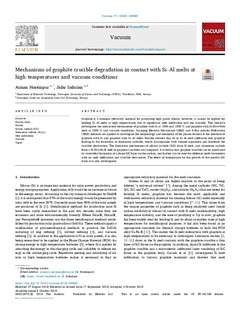| dc.contributor.author | Hoseinpur Kermani, Arman | |
| dc.contributor.author | Safarian, Jafar | |
| dc.date.accessioned | 2019-10-18T10:48:36Z | |
| dc.date.available | 2019-10-18T10:48:36Z | |
| dc.date.created | 2019-10-15T19:02:52Z | |
| dc.date.issued | 2019 | |
| dc.identifier.citation | Vacuum. 2019, 171 108993-?. | nb_NO |
| dc.identifier.issn | 0042-207X | |
| dc.identifier.uri | http://hdl.handle.net/11250/2623065 | |
| dc.description.abstract | Graphite is a common refractory material for processing high purity silicon; however, it cannot be applied for holding Si–Al melts at high temperatures due to significant melt infiltration into the crucible. This research investigates the interaction mechanisms of graphite with Si at 1500 and 1800 °C and graphite with Si-20 wt%Al melt at 1500 °C and vacuum conditions. Scanning Electron Microscopy (SEM) and X-Ray powder Diffraction (XRD) methods are applied to investigate the morphology and chemistry of the phases formed at the interface of graphite with Si and graphite with Si–Al melts. Results showed that Al in Si–Al melt infiltrates into graphite leading to the formation of aluminum carbides, which accompanies with volume expansion and therefore the crucible destruction. The formation mechanisms of silicon carbide (SiC) from Si melt, and aluminum carbide from a Si-20 wt%Al melt in graphite crucibles are compared. It is shown that graphite crucible can be passivated by controlled formation of a dense SiC layer on the surface, and further can be used for different melts treatments with no melt infiltration and crucible destruction. The effect of temperature on the growth of the passive SiC layer was also investigated. | nb_NO |
| dc.language.iso | eng | nb_NO |
| dc.publisher | Elsevier | nb_NO |
| dc.rights | Attribution-NonCommercial-NoDerivatives 4.0 Internasjonal | * |
| dc.rights.uri | http://creativecommons.org/licenses/by-nc-nd/4.0/deed.no | * |
| dc.title | Mechanisms of graphite crucible degradation in contact with Si–Al melts at high temperatures and vacuum conditions | nb_NO |
| dc.type | Journal article | nb_NO |
| dc.type | Peer reviewed | nb_NO |
| dc.description.version | publishedVersion | nb_NO |
| dc.source.pagenumber | 108993-? | nb_NO |
| dc.source.volume | 171 | nb_NO |
| dc.source.journal | Vacuum | nb_NO |
| dc.identifier.doi | https://doi.org/10.1016/j.vacuum.2019.108993 | |
| dc.identifier.cristin | 1737375 | |
| dc.description.localcode | /© 2019 The Authors. Published by Elsevier Ltd. This is an open access article under the CC BY-NC-ND license (http://creativecommons.org/licenses/by-nc-nd/4.0/). | nb_NO |
| cristin.unitcode | 194,66,35,0 | |
| cristin.unitname | Institutt for materialteknologi | |
| cristin.ispublished | true | |
| cristin.fulltext | original | |
| cristin.qualitycode | 1 | |

